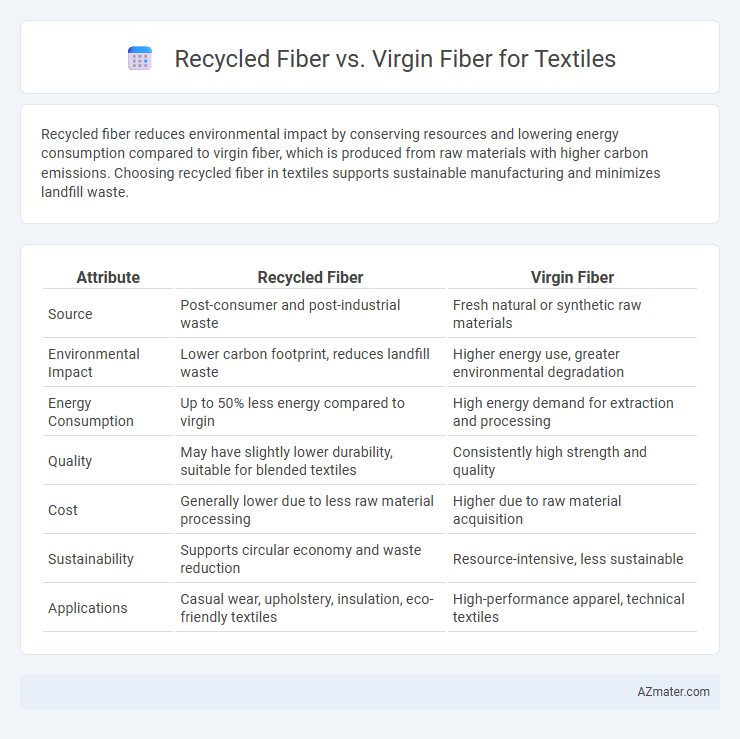Recycled fiber reduces environmental impact by conserving resources and lowering energy consumption compared to virgin fiber, which is produced from raw materials with higher carbon emissions. Choosing recycled fiber in textiles supports sustainable manufacturing and minimizes landfill waste.
Table of Comparison
| Attribute | Recycled Fiber | Virgin Fiber |
|---|---|---|
| Source | Post-consumer and post-industrial waste | Fresh natural or synthetic raw materials |
| Environmental Impact | Lower carbon footprint, reduces landfill waste | Higher energy use, greater environmental degradation |
| Energy Consumption | Up to 50% less energy compared to virgin | High energy demand for extraction and processing |
| Quality | May have slightly lower durability, suitable for blended textiles | Consistently high strength and quality |
| Cost | Generally lower due to less raw material processing | Higher due to raw material acquisition |
| Sustainability | Supports circular economy and waste reduction | Resource-intensive, less sustainable |
| Applications | Casual wear, upholstery, insulation, eco-friendly textiles | High-performance apparel, technical textiles |
Introduction to Recycled and Virgin Fibers
Recycled fiber is produced by processing used textile materials, reducing waste and conserving natural resources, while virgin fiber is derived directly from raw materials such as cotton, wool, or synthetic polymers. Recycled fibers often incorporate post-consumer or post-industrial waste, offering a sustainable alternative without compromising fabric quality. Virgin fibers provide consistent strength and purity, making them ideal for applications requiring high durability and performance.
Defining Recycled Fiber in Textiles
Recycled fiber in textiles refers to fibers made from post-consumer or post-industrial waste materials, such as used garments or fiber scraps, that are processed and transformed into new textile products. These fibers reduce reliance on virgin fiber sources like cotton or petroleum-based synthetics, contributing to environmental sustainability by minimizing waste and lowering carbon emissions. The quality of recycled fibers is improving with advancements in technology, allowing them to be blended with virgin fibers for enhanced fabric performance.
What is Virgin Fiber in Textile Manufacturing?
Virgin fiber in textile manufacturing refers to fibers produced directly from natural or synthetic sources without any prior processing or reuse. These fibers are extracted from raw materials such as cotton plants, wood pulp, or petrochemical-derived polymers, ensuring high strength, purity, and consistency. Virgin fibers offer superior durability and uniformity compared to recycled fibers, making them essential for applications requiring optimal textile performance.
Environmental Impact: Recycled Fiber vs Virgin Fiber
Recycled fiber significantly reduces water consumption and energy usage compared to virgin fiber in textile production, lowering carbon emissions by up to 50%. Virgin fiber, derived from raw materials like cotton or petroleum, demands extensive land use, water, and chemicals, contributing to deforestation and pollution. Utilizing recycled fiber helps divert textile waste from landfills, promoting circular economy practices that mitigate environmental degradation.
Quality and Performance Comparison
Virgin fiber in textiles offers superior strength, consistency, and durability compared to recycled fiber, resulting in higher-quality fabrics ideal for premium applications. Recycled fiber tends to have shorter staple length and reduced tensile strength, which can affect fabric performance, including reduced resilience and pilling resistance. Advances in recycling technology have improved the quality of recycled fibers, but virgin fibers still dominate in terms of overall performance and longevity in textile production.
Cost Differences and Economic Considerations
Recycled fiber in textiles generally offers lower raw material costs compared to virgin fiber, primarily due to reduced energy consumption and less dependence on agricultural resources. Processing recycled fibers can incur higher operational expenses because of sorting and contamination removal, which partially offset material savings. Economic considerations must balance these cost dynamics with environmental benefits and market demand for sustainable fabrics to determine overall viability.
Supply Chain and Availability
Recycled fiber in textiles offers significant advantages in supply chain sustainability by reducing reliance on finite raw materials and lowering environmental impact, yet it faces challenges in consistent quality and volume availability compared to virgin fiber. Virgin fiber, typically sourced from natural plants or synthetic polymers, ensures a steady supply due to established agricultural and petrochemical industries but contributes to higher resource consumption and carbon emissions. Manufacturers increasingly balance these factors by integrating recycled fibers to meet demand while addressing fluctuating supply chain dynamics and environmental goals.
Sustainability and Circular Economy Benefits
Recycled fiber reduces reliance on virgin resources by diverting textile waste from landfills and lowering energy consumption by up to 50% compared to virgin fiber production. Virgin fiber, while offering consistent quality and strength, demands higher water usage and generates more greenhouse gas emissions, impacting sustainability negatively. Incorporating recycled fiber advances circular economy goals by promoting material reuse, reducing textile pollution, and conserving natural resources essential for sustainable textile manufacturing.
Industry Adoption and Market Trends
The textile industry increasingly favors recycled fiber due to rising demand for sustainable and eco-friendly materials, with global recycled fiber market expected to grow at a CAGR of over 10% from 2023 to 2030. Major brands incorporate recycled fibers like recycled polyester and cotton to reduce carbon footprint and water usage, driving widespread industry adoption. Virgin fiber consumption continues but faces pressure from regulatory policies and consumer preferences shifting towards circular economy practices.
Future Outlook: Innovations and Challenges
Recycled fiber in textiles is gaining momentum due to increasing environmental regulations and consumer demand for sustainability, with innovations such as chemical recycling and bio-based fiber regeneration enhancing material quality and scalability. Virgin fiber production faces challenges related to resource depletion, water usage, and carbon emissions, prompting the industry to explore hybrid blends combining virgin and recycled fibers for performance and eco-efficiency. Future advancements in fiber sorting technologies and closed-loop systems are expected to drive cost reductions and higher recycling rates, positioning recycled fibers as a competitive alternative to virgin fibers in the textile market.

Infographic: Recycled fiber vs Virgin fiber for Textile
 azmater.com
azmater.com